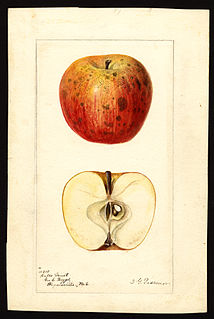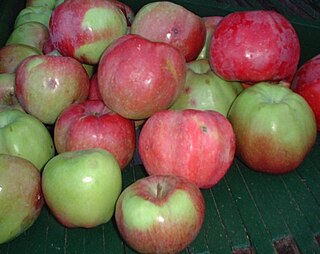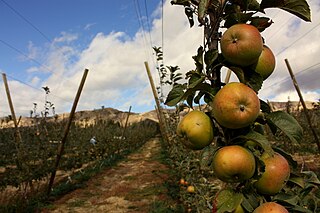
William Drummond, called "of Hawthornden", was a Scottish poet.

A cooking apple or culinary apple is an apple that is used primarily for cooking, as opposed to a dessert apple, which is eaten raw. Cooking apples are generally larger, and can be tarter than dessert varieties. Some varieties have a firm flesh that does not break down much when cooked. Culinary varieties with a high acid content produce froth when cooked, which is desirable for some recipes. Britain grows a large range of apples specifically for cooking. Worldwide, dual-purpose varieties are more widely grown.
The Hawthornden Prize is a British literary award that was established in 1919 by Alice Warrender, having been born at Hawthornden. Authors under the age of 41 are awarded on the quality of their "imaginative literature", which can be written in either poetry or prose. The Hawthornden Committee awards the Prize annually for a work published in the previous twelve months. There have been several gap years without a recipient.

The Baldwin apple is a bright red winter apple, very good in quality, and easily shipped. It was for many years the most popular apple in New England, New York, and for export from the United States of America. It has also been known as 'Calville Butter', 'Felch', 'Late Baldwin', 'Pecker', 'Red Baldwin's Pippin', 'Steele's Red Winter', and 'Woodpecker'.

'Ralls Janet' is an apple cultivar that is also known by many other names. It has been used extensively in modern apple breeding, and has several commercially important offspring. It was grown at Monticello by Thomas Jefferson. It has been said that the name derives from Edmond-Charles Genet, a Frenchman who gave cuttings to Thomas Jefferson, who then passed them on to Virginia nurseryman M. Caleb Ralls, but this claim was not made until about 100 years after the apple became known and may not be accurate.

Antonovka, Антоновка, or Antonówka is a group of late-fall or early-winter apple cultivars with a strong acid flavor that have been popular in Russia as well as in Poland and Belarus. The most popular Russian variety is Common Antonovka, from which other cultivars derive. It was developed by pioneer Russian naturalist and plant breeder Ivan V. Michurin at his experimental orchard in the Tambov Oblast and introduced in 1888. Antonovka is famous for its unsurpassed strong and pleasant fruit aroma.

The Northern Spy, also called 'Spy' and 'King', is a cultivar of domesticated apple that originated in East Bloomfield, New York in about 1800. It is popular in upstate New York.

James Drummond was a botanist and naturalist who was an early settler in Western Australia.

Hawthornden Castle is located on the River North Esk in Midlothian, Scotland. The castle lies a mile to the east of Roslin at grid reference NT287637, and is just downstream from Roslin Castle. Hawthornden comprises a 15th-century ruin, with a 17th-century L-plan house attached. The house has been restored and now serves as a writer's retreat. Man-made caves in the rock beneath the castle have been in use for much longer than the castle itself.

Blenheim Orange is a cultivar of apple. It was found at Woodstock, Oxfordshire near Blenheim in England in about 1740. It has been described as a cooking apple.

The Newtown Pippin, also known as Albemarle Pippin, is an American apple that originated in the late 17th or early 18th century and is still cultivated on a small scale. At one time, there were two very similar apple cultivars known as the 'Yellow Newtown' and 'Green Newtown', one of which perhaps originated as a sport of the other.

White Transparent is an early-season cultivar of apple which is usually used for cooking due to its sharp taste. It is sometimes said to be the same as 'Yellow Transparent', but 'Yellow Transparent' is sometimes described differently, with fine rather than coarse flesh, and a sub-acid rather than acid flavour.

Yellow Bellflower is a cultivar of domesticated apple that originated in New Jersey. It has many other names including "Belle Flavoise" and "Lincoln Pippin". It is probably the best known of a group of apple cultivars referred to as the yellow bellflower group, with fruit that are generally elongated, with largely yellow skin. Along with the Yellow Bellflower, the Ortley is the oldest of the group.

Reinette du Canada or Canadian Reinette is, despite its name, an old French cultivar of domesticated apple. It is a reinette type of golden apple, with much russeting, which keeps shape in cooking and is mainly used for that purpose especially in apple strudel.

Wolf River is an American cultivar of domesticated apple, which originates from the shores of the Wolf River of Wisconsin, in the United States of America, known since 1875. The tree is exceptionally frost hardy and generally disease resistant, and thus keeps well in storage. The fruit usually ripens mid-September to early October. It is large, commonly weighing over a pound, and fairly sweet with a distinctive red and yellow appearance. It has many culinary uses, as it keeps its shape well when cooked.

Liveland Raspberry or Lowland Raspberry is an old cultivar of domesticated apple, first recorded before 1870, that originated from the Livland Governorate of eastern Europe and was introduced into the United States of America in 1883. It is a very early ripening apple.
Emily Berry (1981) is an English poet and writer.

Dumelow's Seedling is a cultivar of domesticated apple that originated at Shackerstone in Leicestershire where it was grown by Richard Dumeller in 1800. It is known by many other names including 'Dumelow's Crab', 'Wellington', 'Doncklaer', 'Beauty', and 'Belle de Vennes'. The fruit is not ready for harvest until October, being one of the last of the season, and keeps well into the next year. Though inferior for use as a dessert apple it cooks well and in early-20th century England was one of the most valuable varieties of cooking apple.
'Autumn Bough' is an early ripening cultivar of domesticated apple also known by various other names including 'Montgomery Sweet', 'Philadelphia Sweet', 'Sweet Bellflower', 'Sweet Harvest', and 'White Sugar'.

Hawley is a large yellow apple cultivar that is used for eating fresh. Although the fruit are delicious, the tree is not very productive, and the fruit are often blemished or rot at the core. It is therefore good as a home orchard tree, but not commercially profitable. The Hawthornden apple has also been incorrectly known as Hawley.


















